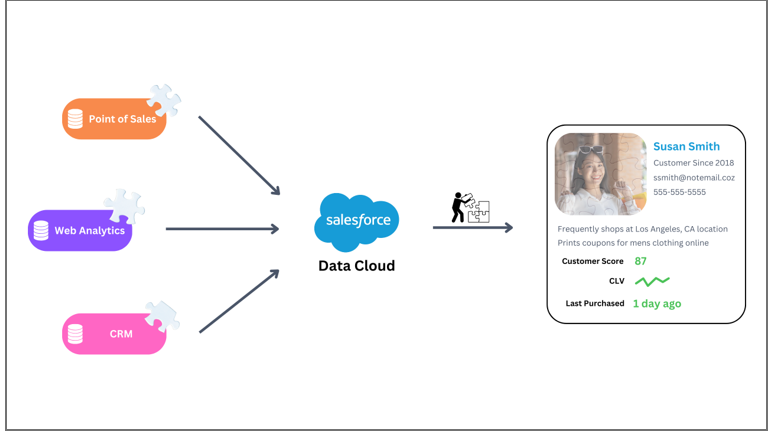Gaining a comprehensive understanding of your customers requires a holistic approach. To do so, you must look beyond individual data sources and consider the bigger picture. Otherwise, your interactions with customers may not be as effective or meaningful.
Think of each of your data sources as providing a single piece of a jigsaw puzzle. Each piece only provides a partial view of your customer. It’s not until the jigsaw puzzle is complete that you get the full picture.
This is where Customer Data Platforms (CDP) come in and provide the necessary tools to gather puzzle pieces and complete the full customer picture.
There are several CDPs to choose from and in this article, I’ll highlight Salesforce’s Data Cloud, provide an overview of how it works, and give a few examples of how you can use Data Cloud to make meaningful impacts to your business.
Is Salesforce Data Cloud right for you?
Before diving into Salesforce Data Cloud, you may first be wondering if any CDP is right for your organization and what value a CDP provides.
Here are just a few examples of benefits that CDPs can help provide individuals within your organization:
- For Executives – enrich your understanding of your customers to better inform your strategic decision making and equip your team with holistic customer views, helping them be more productive and efficient with their duties.
- For Sales - see who your best customers are and keep them happy; likewise, discover which customers have the potential to become excellent customers.
- For Marketers - know your customer’s habits, their likes and dislikes, and craft personalized experiences catered just for them.
- For Customer Support – have rich customer information at your fingertips so that you can provide amazing customer experiences.
Build the puzzle using Salesforce Data Cloud
Let’s now look at how Data Cloud, Salesforce’s answer to CDP, works to collect and assemble customer data.
We'll look at this process in two steps.
Step 1 – Connect Data Cloud to your data sources
Whether it’s Salesforce CRM, website analytics, point-of-sales (POS) systems, S3 data buckets, and so on; wherever customer-related data lives, import it into Data Cloud.
Essentially, in this step, you’re gathering all your puzzle pieces and laying them out in front of you in one big pile.
Step 2 – Harmonize and assemble
Now that you have all your customer–related data in one place, harmonize it and create a unified individual customer view. Harmonizing is the process of seeing how the pieces connect to the overall puzzle. It’s like looking at the sides of a puzzle piece to see how you can join it with another piece.
Just like with a jigsaw puzzle, start with what you know, such as the obvious edge pieces and work to fill in the rest from there.

What you get at the end of step two, is what Data Cloud calls a Unified Individual Profile. This is the individual record providing the most relevant contact and engagement information for your customers, aggregated from all the systems you connected to in step one.
The puzzle is complete! Now what?
Analyze, segment, and act!
Now that the puzzle is complete and you have a more comprehensive view of your customers, you now have the perfect opportunity to use this powerful view of your customers to analyze them in impactful ways.
Salesforce Data Cloud includes a Calculated Insights engine where you can get into the business intelligence mindset and gain insights using Data Cloud’s no-code interface.
Once you’ve built insights, share them with downstream systems by building segments and activation flows. You can easily activate the data to Marketing Cloud, Google Ads, and AWS (Amazon Web Services) S3, just to name a few.
Conclusion
That's it! We’ve walked through the whole process of importing data into Data Cloud, connecting the pieces to build a Unified Individual Profile, analyzed our new comprehensive views, and activated insights by triggering further actions in connected systems.
Let’s conclude by highlighting how Salesforce Data Cloud can be used in various industries.
- For eCommerce – tie in your customer’s purchase history and make the products they are most likely to purchase front-and-center the next time they visit your site. Take it even further by using predictive AI (Artificial Intelligence) to display promotions for other products they may have an interest in to increase cross-category product penetration.
- For medical clinics – combine patient records from various health systems to gain a comprehensive patient record in a HIPPA-compliant system, getting the full picture of your patient's health history so that you can make well informed diagnosis and recommendations.
- For internet service providers – pull together and segment support requests from several facets so that you can display the most relevant self-service support materials to reduce support calls and truck-rolls.
- For auto dealerships, fleets, and trucking – combine individual profile info with telematic and service-records data to predict when a vehicle Is due for a tune-up so that you can send reminders to schedule their next service date – or even better, to auto-schedule the next service date and add it to their calendar.
- For subscription services – sometimes, the “best” customers are those who subscribe to a service, never miss a payment, but who hardly ever use the subscribed service. Identify these customers so that on rare occasions they do use the service, you know to provide exceptional service to keep them happy and subscribed.
Interested in learning more about Salesforce Data Cloud?
XCentium is a proud Salesforce partner with multiple professionals who are equipped and ready to assist you with your needs.
Get in touch with us now and let’s discuss how Data Cloud can provide value for your organization.

